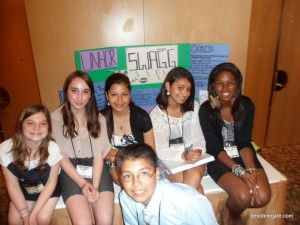
The NGO Forum was one of many unique features of the YMCA MUN Summit. Students created their own NGOs and displayed them to the entire conference during an "NGO Expo" (think Model UN meets Science Fair).
Over 650 middle school students 6-8th grade attended the YMCA MUN Summit in Irvine, California, hosted by the California YMCA Youth & Government this past weekend.
While every MUN conference is different, the YMCA MUN Summit departs significantly from your typical conference. Its focus is not to create a completely accurate simulation of the UN, but to use Model UN as a vehicle to teach students about democracy and develop empathy for international issues.
YMCA MUN does many things differently from other MUN conferences, like having student elections and letting students create their own NGOs — and as a result, it’s one of the most innovative MUN conferences I’ve ever attended.
California YMCA Youth & Government: Model UN as a Vehicle for Democracy
YMCA MUN is a program of California YMCA Youth & Government (CalYMCA) that serves 650 students in the 6th, 7th, and 8th grades across California. YMCA MUN comprises two conferences: Camp Bob, a 3-day training conference that takes place in late March at Camp Roberts near Paso Robles, and the YMCA MUN Summit, a 4-day conference that takes place in early May at the Irvine Hyatt.
Unlike typical MUN conferences, students attend Camp Bob and the Summit as a delegation of their local YMCA, not their school. Students are also called “ambassadors” instead of “delegates.” And the most striking difference is how young the ambassadors are –- but also how articulate they can be. Check out this video of YMCA MUN Secretary-General Riley Owen, an 8th grader addressing a crowd of 650 other middle school students plus their advisors and the conference staff:
In addition to a middle school MUN program, CalYMCA runs a Model Legislature & Court program (MLC) for high school students. MLC is a simulation of state government that involves 2,500 California students every year. Besides California, about 40 other states have YMCA Youth & Government organizations (Y&G) and almost all offer MLC; only a handful do MUN, including Pennsylvania, Louisiana, and North Carolina.
CalYMCA believes in using MUN as a vehicle to build “values-based leadership and civic engagement in California’s youth in order to strengthen participation in our democracy.” They’re not concerned with following what other MUN conferences do or creating a realistic simulation of the UN – and that’s where its differences and innovations begin.
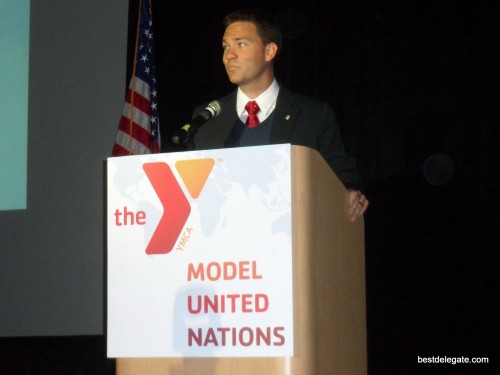
YMCA MUN Program Director Mike McFadden
The Secretary-General Election: 7th Graders Give Speeches in Front of 650+ People
The first key difference for YMCA MUN is that students from different delegations run for leadership positions during Camp Bob and the Summit. This differs from a typical MUN conference, which is run by a single school’s MUN club, and leadership positions are decided well before the conference takes place.
Having elections creates a vibrant energy in YMCA MUN. Before both Camp Bob and the Summit, students from each delegation prepare posters and campaign speeches. During the conferences, they run to be chairs, presidents, and YMCA MUN’s highest position, Secretary-General. Students walk into conference-wide meetings chanting the names of the candidates they support and parading campaign posters.

Students run for leadership positions like Secretary-General during the conference, and they create posters, give campaign speeches, and encourage other students to help them get elected.
Each leadership position has various responsibilities. Chairs and presidents run their committees with the help of conference staff, typically a high school student volunteer from MLC or an adult advisor. YMCA MUN is the only conference I’ve seen where middle school students get to chair and manage a committee of other middle school students.
The Secretary-General is the student face of the conference. He and his cabinet of Assistant Secretaries-General, Deputy SG, and a Chef-du-Cabinet form the Office of the Secretary-General. Their role is to manage the substantive output of the conference, which includes reviewing resolutions passed by the conference and providing crisis updates.
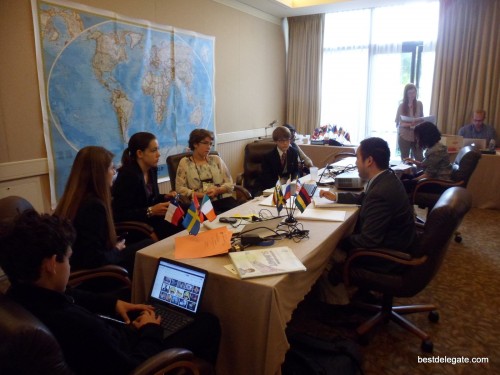
The Secretary-General and his cabinet form the Office of the Secretary-General, which reviews the conference's substantive proposals and resolutions. The office was managed by volunteers Richard Hsu and Wallis Locke.
The election of the Secretary-General is particularly dramatic. Current 7th graders campaign during the Summit to be the Secretary-General for next year’s events, and they have to give speeches in front of the entire conference — that’s nerve-wracking for anyone, let alone a 12-year-old! But they pull it off in style:
Although elections are unique to YMCA MUN, their effect on students is similar to a common feature of other MUN conferences: awards. Students’ emotions rise and fall at other MUN conferences depending on whether they receive the award they expected or not, and it was a similar case at YMCA MUN depending on whether or not students got elected.
But unlike awards, losing an election teaches students – even as young as middle school – a concrete lesson. I asked one 7th grader who ran for Secretary-General what he learned at the Summit, and he told me, “If you’re gonna run for something, you’ve gotta be ready for criticism, and be ready to lose or to win.”
This practice of elections is imported from MLC, where students run for election to various state government offices, and it supports CalYMCA’s mission of teaching students about democracy.
The NGO Forum: Build Your Own Non-Governmental Organization
The Summit features traditional MUN committees, including the GA Main Committees, ECOSOC, Security Council, and ICJ. But one of its coolest innovations is the creation of a 150-person NGO Forum.
In the NGO Forum, students formed teams and created their own non-governmental organization in response to a humanitarian crisis. This was my favorite part of the conference because it successfully ignited young students’ passions for international issues. Check out this video of a 6th grader excitedly explaining her group’s NGO:
In traditional MUN committees, students are tasked with developing solutions to a topic and writing them into a resolution. Other MUN conferences also simulate NGO Forums, where students represent NGOs and they visit other committees to provide an NGO perspective on their solutions and resolutions.
But at YMCA MUN’s NGO Forums, students build their own NGOs. On Thursday and Friday of the Summit, students share their research on the topic and brainstorm possible solutions. They come up with an NGO name and logo, and they work together to create posters, business cards, and talking points to explain their NGO to the public.

In the NGO Forum, students formed groups to address a humanitarian crisis and develop their own NGO.
On Saturday, every team puts their NGO on display to the entire conference during an “NGO Expo” — think Model UN meets Science Fair:
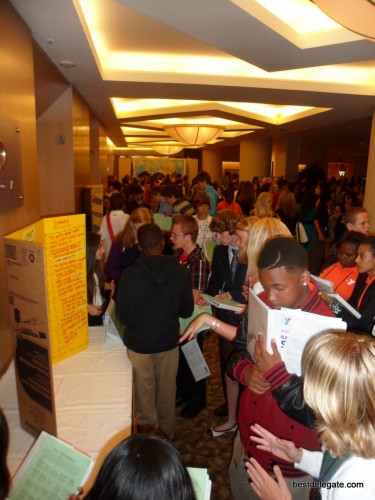
Students in the NGO Forum put their NGO on display to the entire conference during an "NGO Expo."
Students were encouraged to learn about each NGO by completing an “NGO Bingo” worksheet, and to think about how they would bring what they learned back to their communities:
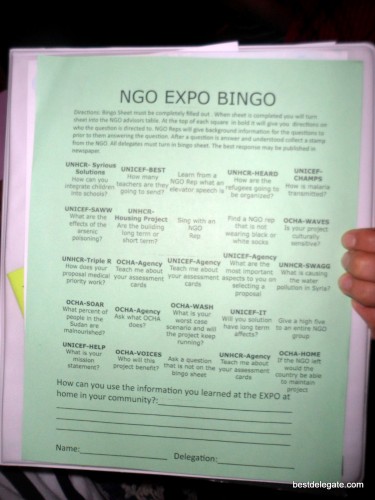
Students were asked to complete an "NGO Expo Bingo" in order to learn about each NGO.
The NGO Forum was the brainchild of Dan Strode, a YMCA MUN volunteer who has worked with the United Nations to relieve humanitarian crisis situations, including serving as an operations manager for the Cooperative Housing Foundation in Haiti.

M-U-N is F-U-N! Age-Appropriate Activities, Social Events, and Games
Probably the biggest difference between YMCA MUN and other MUN programs, even middle school ones, is its recognition that their students are still kids. Consequently, the schedules for both Camp Bob and the Summit feature a lot of time spent outside of committee on social events. Many events let the students just have fun, such as icebreakers, games, scavenger hunts, and dances:
Many of the events were also cultural, including performances by local arts groups throughout the summit and a Saturday night dinner with foreign dignitaries:
YMCA MUN also places a larger emphasis on student supervision than other conferences. The conference staff includes a resident medic and several “deans” who can manage behavioral and disciplinary student issues. Multiple adults are available during social events and advisor meetings focus on how to best supervise students.
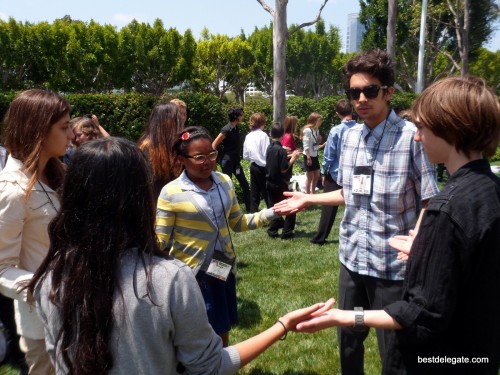
Students got a chance to play outside during the YMCA MUN Summit, where they were well-supervised by advisors and conference staff.
Why You Should Join YMCA MUN
I was really impressed with YMCA MUN. CalYMCA’s approach to Model UN differs from most MUN groups, being unconcerned with a realistic portrayal of the UN, and instead focusing on using Model UN as a vehicle to reach their educational goal for young students, which is to learn democracy.
As a result, their Model UN conferences are very different than typical conferences, but some of these differences — elections, the NGO Forum, and simply existing as an opportunity for middle school students to do MUN — are interesting innovations that other conferences should consider.
And most importantly, they leave a lasting, positive impact on their students. Don’t just take that from me — watch the video below to hear 6th and 7th graders explain why other students should join YMCA MUN:
Congratulations to all ambassadors, advisors, volunteers, and the California YMCA Youth & Government staff on a wonderful Summit! And special thanks to Mike McFadden, Richard Hsu, and Stefanie Yoshii for having me visit and letting me be a part of YMCA MUN!
Did you have fun at YMCA MUN? Let us know in the comments below!
Also, click here to see more pictures and video of the YMCA MUN Summit!

